So many games and so little time! It’s amazing how much of a console’s library can still be discovered so many years after it’s off store shelves, and Sega’s machines are still producing new experiences decades after they’ve been officially discontinued. For fans though, no machine ever dies! Read on and see what our staff and readers were playing in May!
Batman Returns (Game Gear) By Ken Horowitz
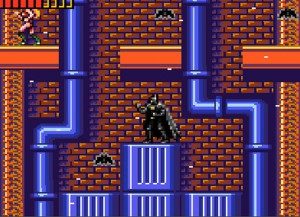 Most people tend to think of the SNES version of Batman Returns as the best, and as far as the console versions go, I tend to agree. I’ve yet to play any of the other handheld renditions, but I must say that the Game Gear version is quite good! Great visuals and sound, and gameplay that’s not stiff and clumsy (hello Genesis version!) make this one a lot of fun to play. The grappling hook is not only easy to use, but it’s actually useful. I can’t help but feel that some areas in the Genesis Batman Returns kind of shoehorned it in, but on the Game Gear it’s simple and effective.
Most people tend to think of the SNES version of Batman Returns as the best, and as far as the console versions go, I tend to agree. I’ve yet to play any of the other handheld renditions, but I must say that the Game Gear version is quite good! Great visuals and sound, and gameplay that’s not stiff and clumsy (hello Genesis version!) make this one a lot of fun to play. The grappling hook is not only easy to use, but it’s actually useful. I can’t help but feel that some areas in the Genesis Batman Returns kind of shoehorned it in, but on the Game Gear it’s simple and effective.
I think the slow pace of the gameplay is my only real complaint. The game kind moves along a bit too leisurely, but it’s not painfully slow. The solid control and the variety of the environments really help to alleviate the problem. I still hold NES Batman as my all-time favorite old school Caped Crusader adventure, but Batman Returns on Game Gear is definitely one of the better titles out there.
Burning Force By Sebastian Sponsel
I got this game when I was about ten years old, so this was one of the first Mega Drive games I ever owned. True story: While many people say that Burning Force isn’t just a Space Harrier clone, back when I picked this game up I actually chose it over Space Harrier II – I didn’t know which of these had come first, and without the legacy bonus I actually preferred the look and feel of Namco’s knock-off homage over the official sequel. Actually I still kind of do, really. While many critics complain that you’re only allowed to freely roam across the entire screen every third stage (and in the bonus stages) and are “just” jet skiing most of the time, I actually prefer it that way. Maybe it’s just me, but I always feel there’s something off about the way the protagonist in Space Harrier just sort of slides though the air. Burning Force’s hero Hiromi, meanwhile, wins my approval simply by virtue of having a sweet hoverbike that turns into a spaceship!
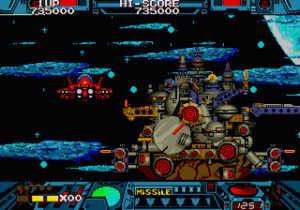 Another true story: When I was a kid I, while fooling around with a pair of those cheap red-and-blue anaglyph 3D glasses, I noticed that wearing those while playing Burning Force kind of reinforced the floor warping effect. It seemed like the image gained more depth, while at the same time the character and enemy sprites moved across the screen like flat paper cutouts. I was really fascinated by that effect. Unfortunately the resulting image also made me really dizzy in the long run.
Another true story: When I was a kid I, while fooling around with a pair of those cheap red-and-blue anaglyph 3D glasses, I noticed that wearing those while playing Burning Force kind of reinforced the floor warping effect. It seemed like the image gained more depth, while at the same time the character and enemy sprites moved across the screen like flat paper cutouts. I was really fascinated by that effect. Unfortunately the resulting image also made me really dizzy in the long run.
Nowadays, Burning Force is one of these games that I like to play every once in a while, but I haven’t really felt the urge to really try and complete it all the way through. It’s competent, and yes, I actually still prefer it over Space Harrier II. What can I say? I wanna have that bike!
Landstalker By Paige
Well, it took far too long, but I finally got through Landstalker. I was admittedly apprehensive about playing through this one—I grew up with and absolutely love Light Crusader, so hearing that Landstalker is considered by many to be the better game had me both intrigued and uneasy. But I decided to play it. After all, if it is more enjoyable than Light Crusader, I must be in for a real treat!
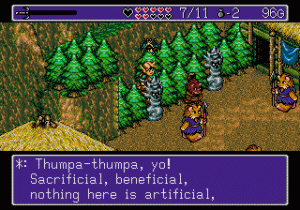 And a treat it was! I was pleasantly surprised by how much I enjoyed playing through this game. The story was interesting enough to keep me engaged… I mean, who wouldn’t want to play as a kind-of selfish, very greedy elf-dude (who I thought was a cat for some reason) named Nigel who’s only willing to go on this adventure for a boatload of money? Of course, along the way Nigel gets duped into helping out the residents from the villages he encounters, and there are these dramatic twists and turns the plot takes as well. I personally enjoyed watching as Friday, the little fairy girl who knows where these grand spoils are, get jealous whenever a female character looks as though she’s trying to make a move on Nigel.
And a treat it was! I was pleasantly surprised by how much I enjoyed playing through this game. The story was interesting enough to keep me engaged… I mean, who wouldn’t want to play as a kind-of selfish, very greedy elf-dude (who I thought was a cat for some reason) named Nigel who’s only willing to go on this adventure for a boatload of money? Of course, along the way Nigel gets duped into helping out the residents from the villages he encounters, and there are these dramatic twists and turns the plot takes as well. I personally enjoyed watching as Friday, the little fairy girl who knows where these grand spoils are, get jealous whenever a female character looks as though she’s trying to make a move on Nigel.
There are only two things about this game I didn’t really like: that Nigel can only move in four directions, not all eight, and the fact that it was very hard at times to determine where either Nigel was in relation to the various platforms/items or where the platforms/items were in relation to each other. I personally think some shadows on the ground would have done wonders. And really, the fact that position/distances were hard to gauge sometimes was what made certain obstacles or puzzles frustrating for me (the puzzles by themselves aren’t difficult or anything).
At the end of the day, I really had fun playing through Landstalker. I can see why it gets compared to Light Crusader so often, but truthfully in my eyes each game sets out to do something different—maybe I’ll play through Light Crusader again and expand on that in a later Reader Roundtable entry. I’m very glad I had the pleasure of playing through this gem!
Saint Sword by David Dyne
Taito’s releases on the Genesis didn’t produce the most memorable lineup of games but there are some unique gems, such like the fantasy themed action platformer Saint Sword. As Macress, your quest is to confront and destroy the evil Gorgan and her slew of palette swapped minions, not once, but twice as the game pulls a Ghouls ‘n Ghosts and sends you back to the beginning for another more difficult run through to the final showdown. Along the way, you’ll hack your way through dozens of similar enemies to gain experience which in turn levels up Macress to increase his attack and damage rate and collect orbs to increase your health, magic points and transformations (more on that in a moment). Staying fully powered up is essential as enemies go down much faster and you can keep pushing forward to find the key that’s required to open the door to the next stage or the end of level guardian before the clock runs out.
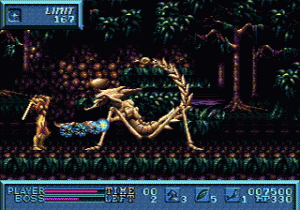 For the most part the boss battles are fairly simple affairs where you transform into one of the three forms such as the winged warrior granting you flight, the merman (no, it’s not the Creature from the Black Lagoon!) which makes the water sections easier to traverse and the centaur who’s best suited for Gorgan’s final form and not much else. Bosses have very basic patterns so once you’ve figured out the right transformation to use, the necessary spell or the sweet spot where you can hit them but they can’t hit you, they tend to go down rather quickly.
For the most part the boss battles are fairly simple affairs where you transform into one of the three forms such as the winged warrior granting you flight, the merman (no, it’s not the Creature from the Black Lagoon!) which makes the water sections easier to traverse and the centaur who’s best suited for Gorgan’s final form and not much else. Bosses have very basic patterns so once you’ve figured out the right transformation to use, the necessary spell or the sweet spot where you can hit them but they can’t hit you, they tend to go down rather quickly.
There’s a small roster of items you can collect after defeating each boss most of which aren’t all that useful except for the meat that will restore your health provided you have enough magic points to utilize it. It’ll come in handy in the later stages especially on the second loop when a single death can really screw you over if you’re not careful.
While it may not be the most original or innovative title on the system it’s still worth a look. Like most Taito titles, the game features a better than average soundtrack, with stage one, stage two, and the boss theme being my personal favorites.
Strider By Joseph C.
Strider is one of those well-known Mega Drive games that I somehow never played during the system’s retail life. There was a Sega guide book I used to borrow from my school library that covered many early Mega Drive games, and Strider was one that I always looked at with great interest. I never played it at the time though, and I never found it in stores, in friend’s collections or even at garage sales.
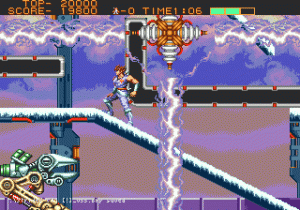 It was only a couple of years ago that I first picked up the game, and I briefly played it then and honestly wasn’t too impressed. This month, I got the 2014 version for PC, and before booting it up I decided to give the original another go; I’m honestly still not impressed. The game is really choppy, and there is frequent slow down. The hit detection seems to be all over the place. Maybe I’m just getting old, or maybe I had to be there at the time, but I really don’t see what’s so special about this game.
It was only a couple of years ago that I first picked up the game, and I briefly played it then and honestly wasn’t too impressed. This month, I got the 2014 version for PC, and before booting it up I decided to give the original another go; I’m honestly still not impressed. The game is really choppy, and there is frequent slow down. The hit detection seems to be all over the place. Maybe I’m just getting old, or maybe I had to be there at the time, but I really don’t see what’s so special about this game.
I wouldn’t call it bad though because if I thought that, I wouldn’t keep playing it. It just isn’t as good as I expected, given its cult status. Perhaps I should try the sequel or the arcade version? I’ll keep slicing away a bit longer and hope I see what others see.

Pingback: Sega-16 Articles | The Essential Malady